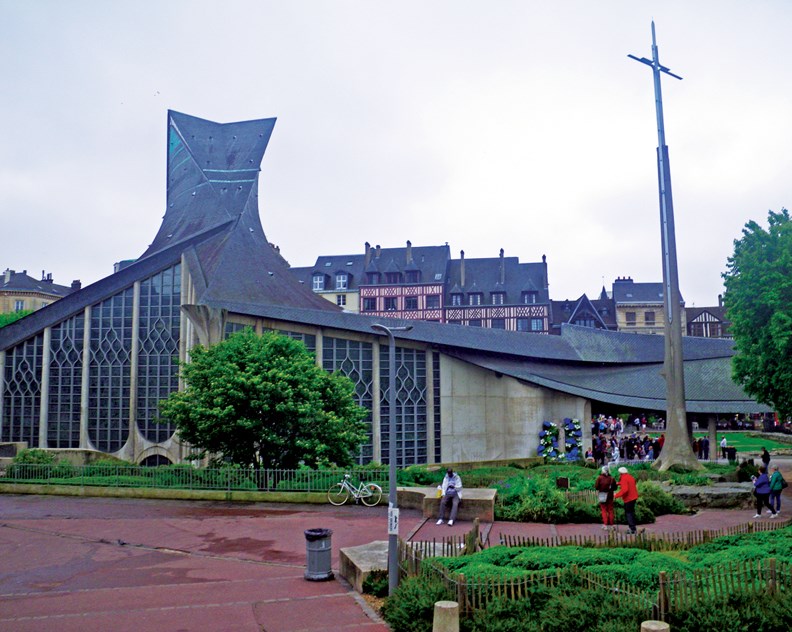The beautiful Viking Rolf ties up along the Seine River at Rouen. After lunch, Anna guides us on a walking tour in Normandy’s historic capital.
Our group of shipmates strolls along the waterfront and across a busy roadway to the edge of the old town centre. Winding along narrow, cobblestone streets, our route passes some of Rouen’s 700 preserved half-timbered houses.
“As one of France’s oldest cities, Rouen was settled over time by Gauls, Romans and Vikings. Sometimes called ‘city of 100 spires,’ steeples dominate its skyline,” grins Anna. “Yet, my hometown is best known as Joan of Arc’s last stand.”
Continuing through a long passageway into a courtyard cemetery, a surprising mummified cat greets us from a glass case. “Likely black, the cat’s remains were plastered into the ossuary’s wall to repel evil,” suggests Anna.
“When St. Maclou’s cemetery became overcrowded with plague victims, the church added this burial space in 1526.”
We learn four of the surrounding galleries were ossuaries that stored skeletons. Macabre carvings of skulls, crossbones, grave diggers’ shovels and hourglasses decorate the oak lintels of doors and windows. These buildings now house part of the Fine Arts School.
Leaving the tranquil enclosure, we approach glorious Rouen Cathedral. “This cathedral was established in 1201 … and completed in 1514. Notice how the intricately sculpted stone façade resembles fine lace,” Anna remarks.
“The soaring spires fascinated artist Claude Monet. Attempting to capture such Gothic beauty, he painted it over 30 times in different light and from different angles.”
Inside the dimly lit interior, we visit two marble tombs decorated with sculpted likenesses of their royal occupants. In one rests Richard the Lionheart, both a famed English king and Norman Duke. In another lies Rolf. In a peace treaty devised to halt his Viking raids, French King Charles III awarded him the title Duke of Normandy and its enormous Dukedom. Rolf was baptized here and in 911, mapped out Rouen.
Proceeding onward, Anna points out the former Parliament of Normandy, Rouen’s present courthouse. “The façade blends French flamboyant and Renaissance styles. This magnificent building replaced Rolf’s earlier court of the exchequer,” Anna recounts. “And a short walk from here stood the 13th century Chateau Bouvreuil, the castle where Joan of Arc was imprisoned, tried and sentenced to death for heresy. Only one squat turret remains, nicknamed the Maid’s Tower.”
Three blocks away, a spectacular Medieval arch straddles Rue du Gros Horloge, old town’s busy main street. Gazing upon the grand Astronomical Clock, we notice its ornate golden face has one hand.
“In the middle ages, knowing only the hour mattered,” smiles Anna. “At the end of our tour, climb the spiral staircase to see the clock’s inner workings, and at the top, sweeping panoramas.”
The street opens onto the old market square. Many of its surrounding Medieval houses now enclose shops, boutiques, florists and restaurants. And continuing public market traditions, two covered halls sell fish, meats, produce and more.
Public humiliations and executions took place in its former centre. A stark iron cross marks the spot where 19-year-old Joan was burned at the stake in 1431. Marking the extent of the pyre, her simple statue graces adjacent Eglise Jeanne d’Arc. Dedicated in 1979, the design of her memorial church evokes the flames that consumed her. The massive 16th century stained glass windows inside were recovered from nearby Saint Vincent’s, severely bombed during WWII.
Sauntering back to our riverboat, we window shop and browse. Discovery of a chocolatier becomes another highlight. Inside, luscious confections tempt us. A selection of macarons, liqueur-laced bonbons and cocoa covered almonds – called Joan of Arc’s Tears – become souvenirs for home folks.



